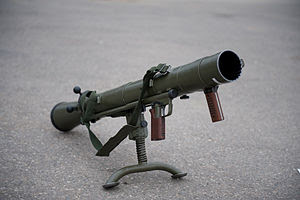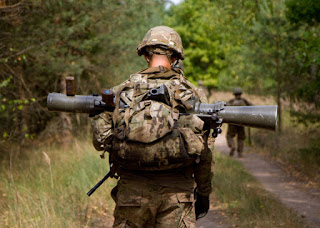From Wikipedia:The Carl Gustaf (Swedish pronunciation: [ˈkʰɑːɭ ˈɡɵ̞stɑːv]; also known as, Gustaf Bazooka and M2CG) is an 84 mm man-portable reusable anti-tank recoilless rifle produced by Saab Bofors Dynamics (formerly Bofors Anti-Armour AB) in Sweden. Although most rounds fired by the Carl Gustav work on the classic recoilless principle, modern rounds sometimes add a post-firing booster that technically make it a rocket launcher.The first prototype of the Carl Gustaf was produced in 1946 as a lightweight anti-armor weapon, one of many similar designs of that era. While similar weapons have generally disappeared from service, the Carl Gustaf remains in widespread use today. A combination of light weight, low cost and widely varied ammunition types, makes the Carl Gustav extremely flexible and able to be used in a wide variety of roles where single-purpose weapons like the M72 LAW passed out of service as newer tank designs rendered them ineffective.In its country of origin it is officially named Grg m/48 (Granatgevär - "grenade rifle", model 48). British troops refer to it as the "Charlie G", while Canadian troops often refer to it as the "84" or "Carl G". In U.S. military service it is known as the "M3 Multi-Role Anti-Armor Anti-Personnel Weapon System" (MAAWS) or "Ranger Anti-tank Weapons System" (RAWS), but is often called the Gustaf or "the Goose" or simply the "Carl Johnson" by American servicemembers. In Australia it is irreverently known as "Charlie Gusto" or "Charlie Gutsache" (guts ache, slang for stomach pain).[5]The United States Army will soon begin distributing a weapon system introduced in 1946. The M3 Carl Gustav rocket launcher will bolster the firepower of rifle platoons, giving them a much-needed edge. Developed by Bofors (now Saab), the Carl Gustav is a lightweight, man-portable recoilless rifle. Recoilless rifles are like a cross between an artillery gun and a bazooka: While they have propellant at the base of the projectile like a rocket, the propellant doesn't burn beyond the barrel, meaning the projectile flies unpowered like a bullet or artillery shell. Unlike artillery, propellant gasses are directed backwards, counteracting the weapon's recoil and making it "recoilless". The weapon is referred to as a "rifle" due to the spiral rifling in the barrel, which stabilizes the projectile.The story continues:The U.S. Army fielded a number of recoilless rifles after World War II, in calibers from 57-millimeter to 106-millimeter. The Army saw these rifles as anti-tank weapons meant to counter the T-55 and T-62 tanks of the Soviet Army. The Army retired these weapons when Dragon and TOW anti-tank guided missiles came on the scene.The end of the Cold War and the rise of new threats such as Iraqi guerrillas and the Taliban posed a problem for the U.S. The shaped charge warheads of anti-tank missiles are less effective against buildings, bunkers, and enemy troops in the open. Anti-tank missiles are also very expensive, meaning you could spend up to $50,000 to blow a $500 mud hut to smithereens. Finally, anti-tank missile launchers with their complex guidance systems are heavy and difficult to lug though rough terrain.The M3 Carl Gustav solves all three problems. The weapon is basically a tube with grips and an aiming sight. It can fire High Explosive Anti-Tank (HEAT) rounds to take out tanks and armored vehicles, and High Explosive (HE) rounds meant to attack structures and enemy personnel. The shells have a diameter of 84 millimeters—or 3.3 inches—meaning they can pack a real punch. The individual rounds are relatively inexpensive, and the launcher weighs just 14 pounds.U.S. Special Operations units, who need portable, lightweight firepower, have been toting the M3 Carl Gustav since 1989. Some regular infantry units in Afghanistan have carried the Carl Gustav since at least 2011, but they had to request and show a need for the weapon to get it. Now, Infantry Brigade Combat Teams in the U.S. Army and National Guard will receive these weapons at a rate of 27 per brigade, or one per platoon of 40 soldiers.Despite the Carl Gustav's age, it's actually more versatile than many high tech weapons, making it useful in tomorrow's conflicts. In the new "hybrid warfare" pioneered by Russian forces in the Crimea, armies could face "little green men" (paramilitary troops) one moment and armored vehicles the next. The M3 will be able to counter both. Not bad for a 70-year-old weapon.
The ORIGINAL gathering place for a merry band of Three Percenters. (As denounced by Bill Clinton on CNN!)
Wednesday, May 25, 2016
Army catches up with 1946. What was old is new again. More on the Carl Gustav
Subscribe to:
Post Comments (Atom)


6 comments:
An interesting evolution in many ways.
I have to admit a certain hesitancy about the implications of the Army fielding this system with so many ordinary combat units...it is an important capability, but one that is supposed to be covered by combined arms. I felt much less ambiguous when the Carl Gustav made a comeback with special forces, units which frequently must operate with minimal conventional support.
The Carl Gustav itself is a great weapon system...but I worry that this is an indication that we're asking far too much of our infantry (of course, that situation is pretty much a given).
As weapons systems go, it's still newer than "Ma Deuce", the Browning M2. The early versions of what became the M2 were developed in 1921 and the version designated M2 in 1930.
Although I used the LAW, Dragon, and TOW missile systems while in the Army, I always thought it's utility was wrong, because it was both so expensive, and you could not carry but a few of them with you on a M113, or on foot. 81mm mortars were actually more effective in my experience. I was trained with the 90mm and 106mm Recoiless Rifles, and liked them much better, as you could get more rounds down range, they were effective, and cheaper. That high tech crap just set us up to fail in asymmetrical warfare, both financially, and tactically. Chiu, in a mechanized Infantry Battalion, there is a Combat Support Company. There is a Heavy Mortar Plt, (107mm or 4.2 inch, your choice as to what to call them), A Recon Plt., an Anti-Tank Plt, (TOW), a Stinger Section, Ground Surveillance Radar Section, and other support and hdqtrs. people. The Combined Arms you refer to is Tactical and Strategic Air, (fixed wing and helicopters) and Artillery, both rocket and cannon. The Gustav is a needed addition to the Infantry, replacing TOW, Dragon, an LAW. If you had any actual experience in Combined Arms use, which I doubt, you would know that the troops, the guys with the guns in their hands, have been asking for something like this return to sanity for at least forty years. More ammo, re-fireable, and useful against day to day targets like huts and other low value targets, bingo. The Army is very stingy with that expensive crap, and few are ever allowed to practice with them in peace time, which affects, you know, READINESS. Even officers have been hesitant to use the expensive stuff because the know how many a battalion has, and how hard they are to get. Units have budgets! And if you're worried about asking too much of our infantry, welcome to the party pal. Between social engineering and fiascos-in-waiting like the dithering about rifles, pistols, and the arrival of skirts, it remains the same as it ever was, a clusterfuck. Evolution my ass, we're getting back to what WORKS.
I was in 1st Bn. thirty years ago. Our AT sections used the 90mm then. The move to the Carl, I believe, had as much to do with ammo availability as anything else. It was a good weapon then. It would still work today.
I guess the other side of the equation is that this makes me wonder how wise it really is to be spending so much on capabilities that theoretically exist to take some of the burden off the infantry when they do not, in fact, accomplish that.
So if it's a rifle, then the citizens should be allowed to own one ?
Post a Comment